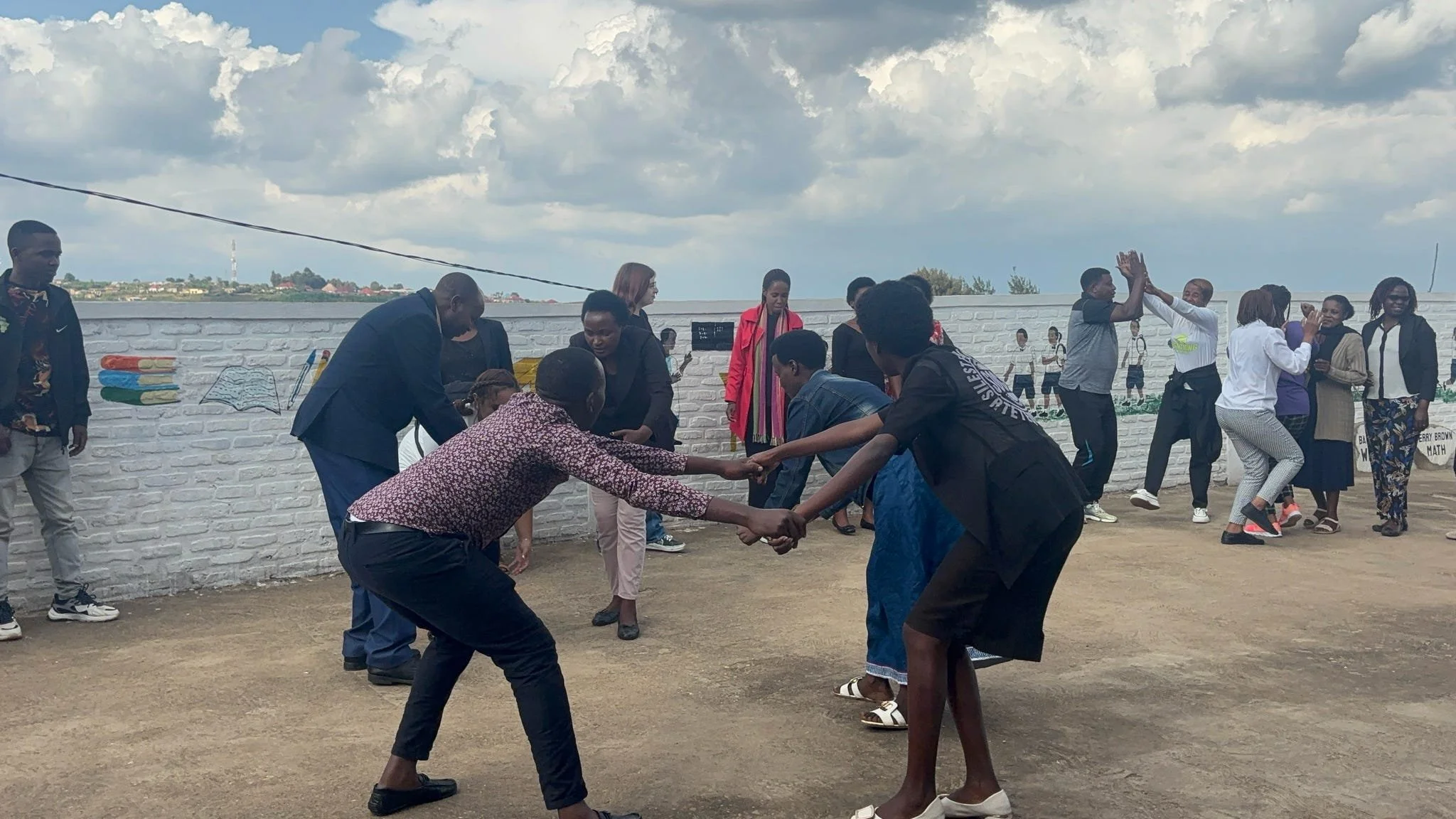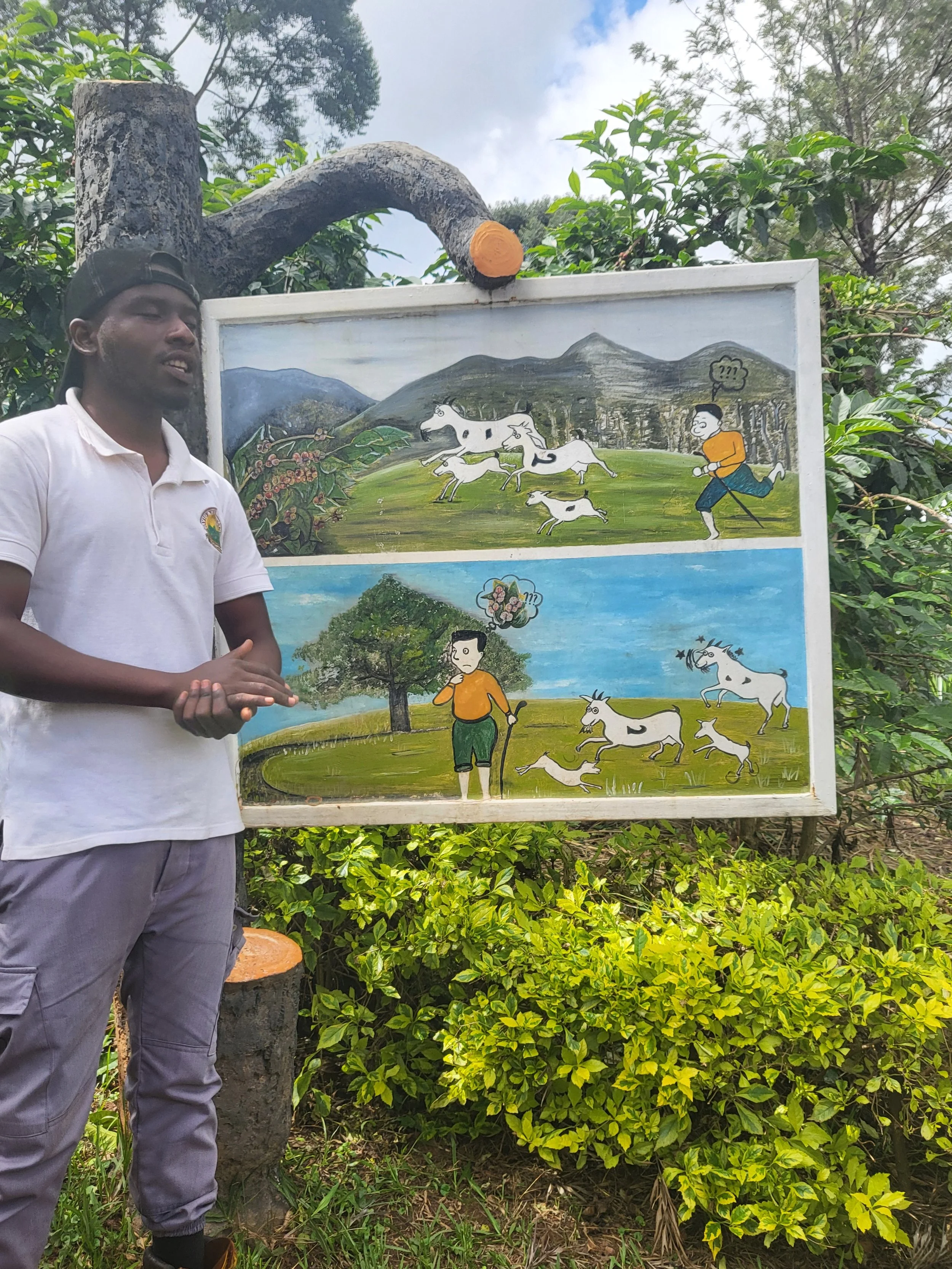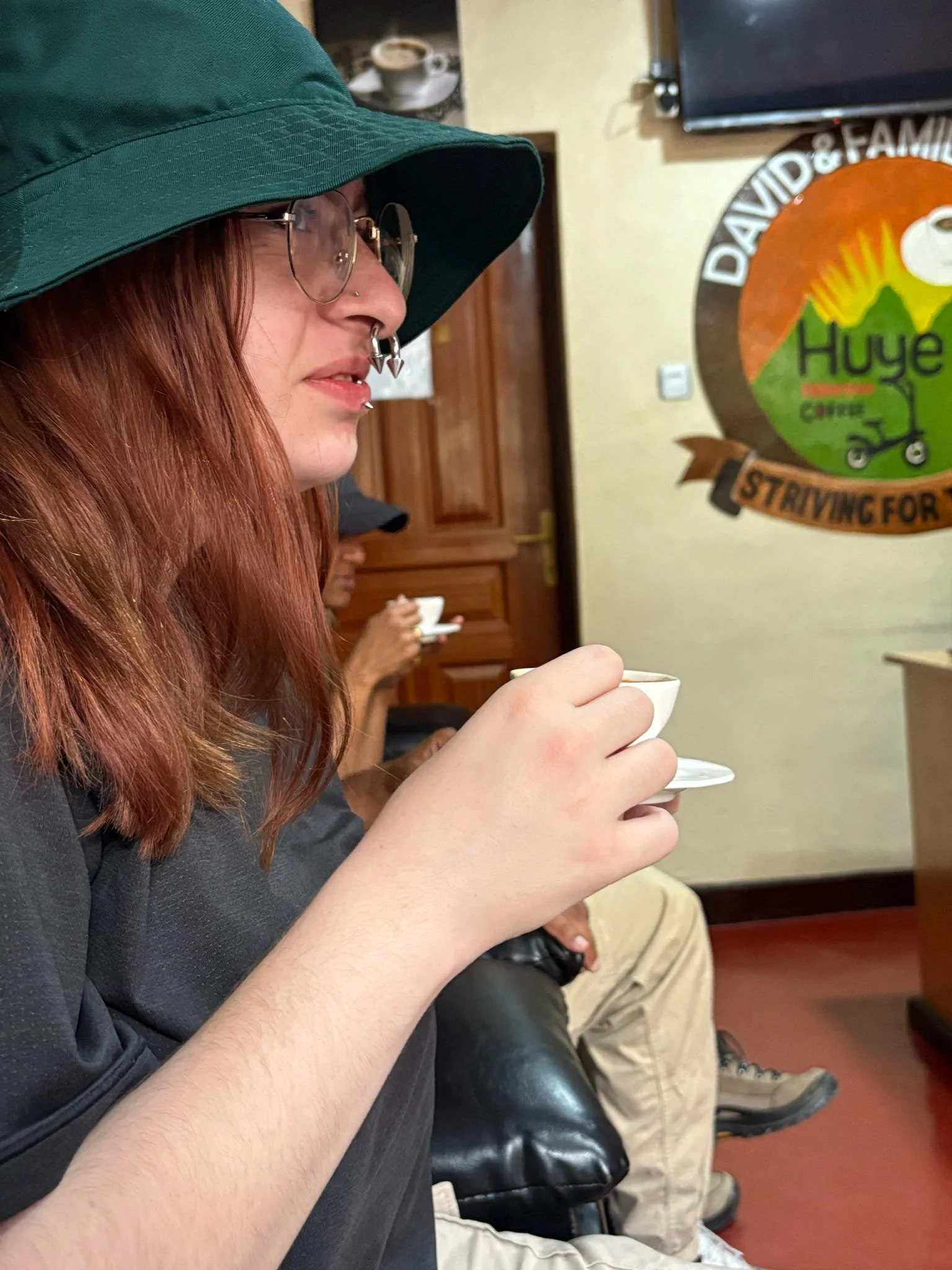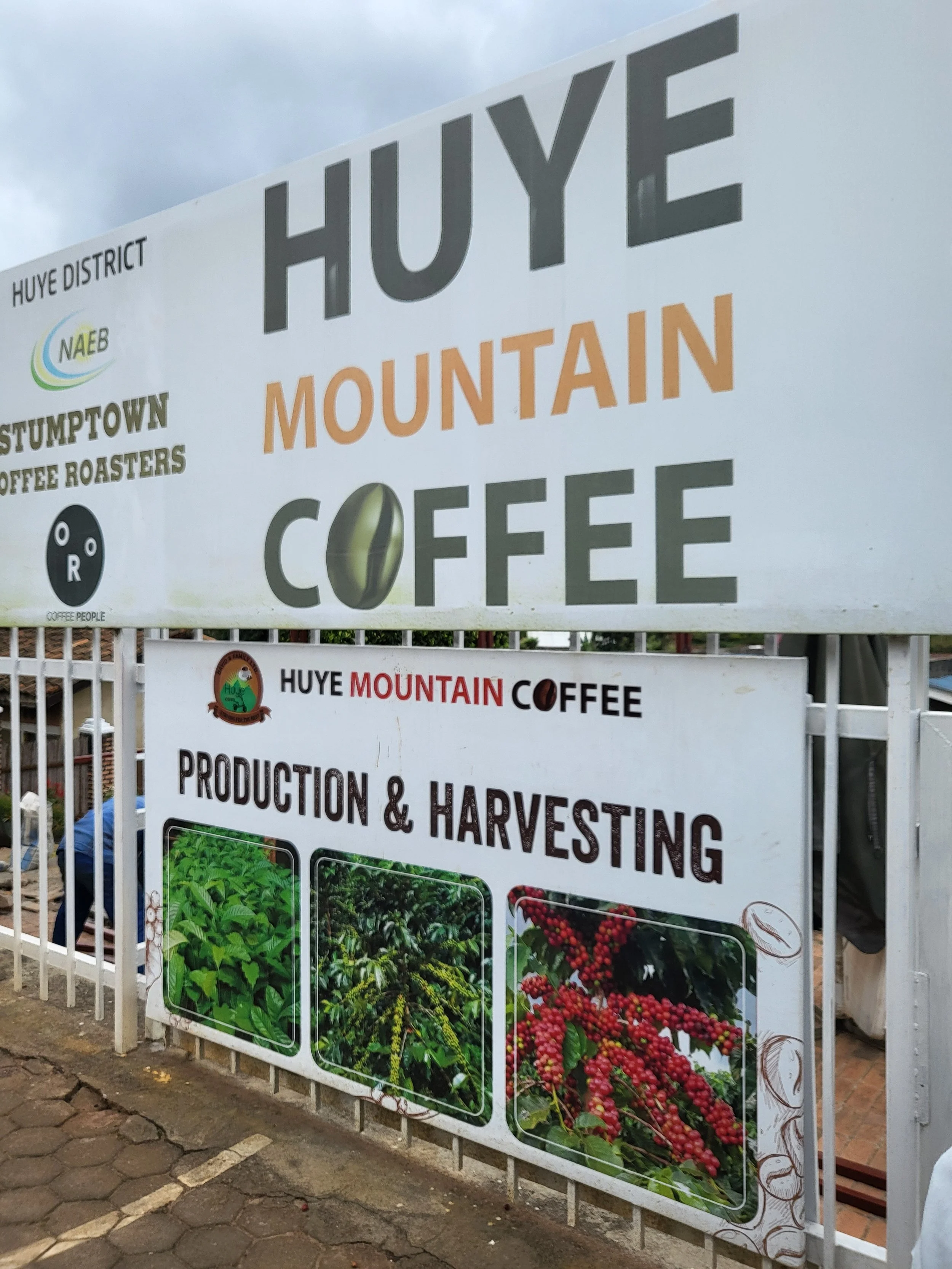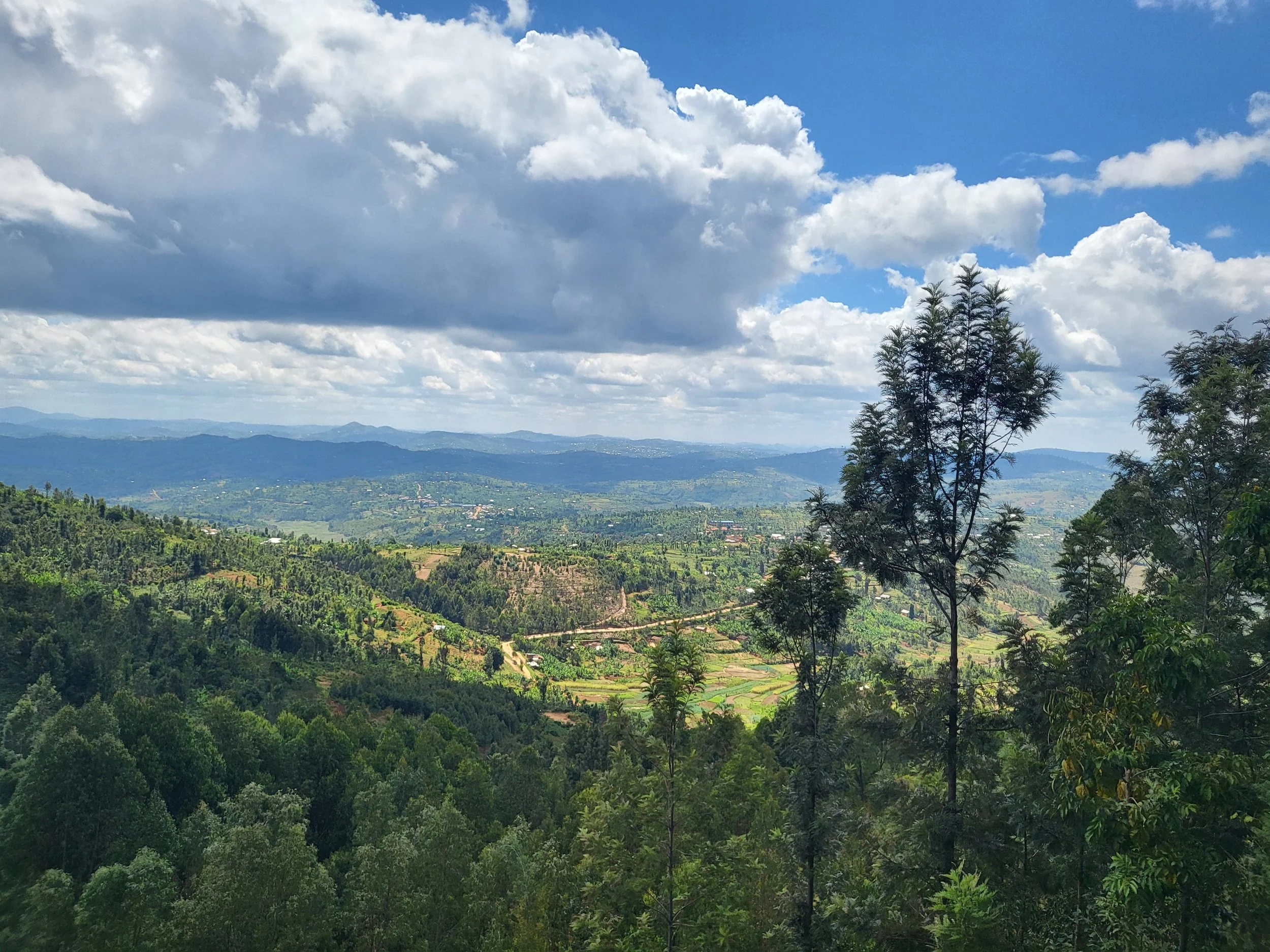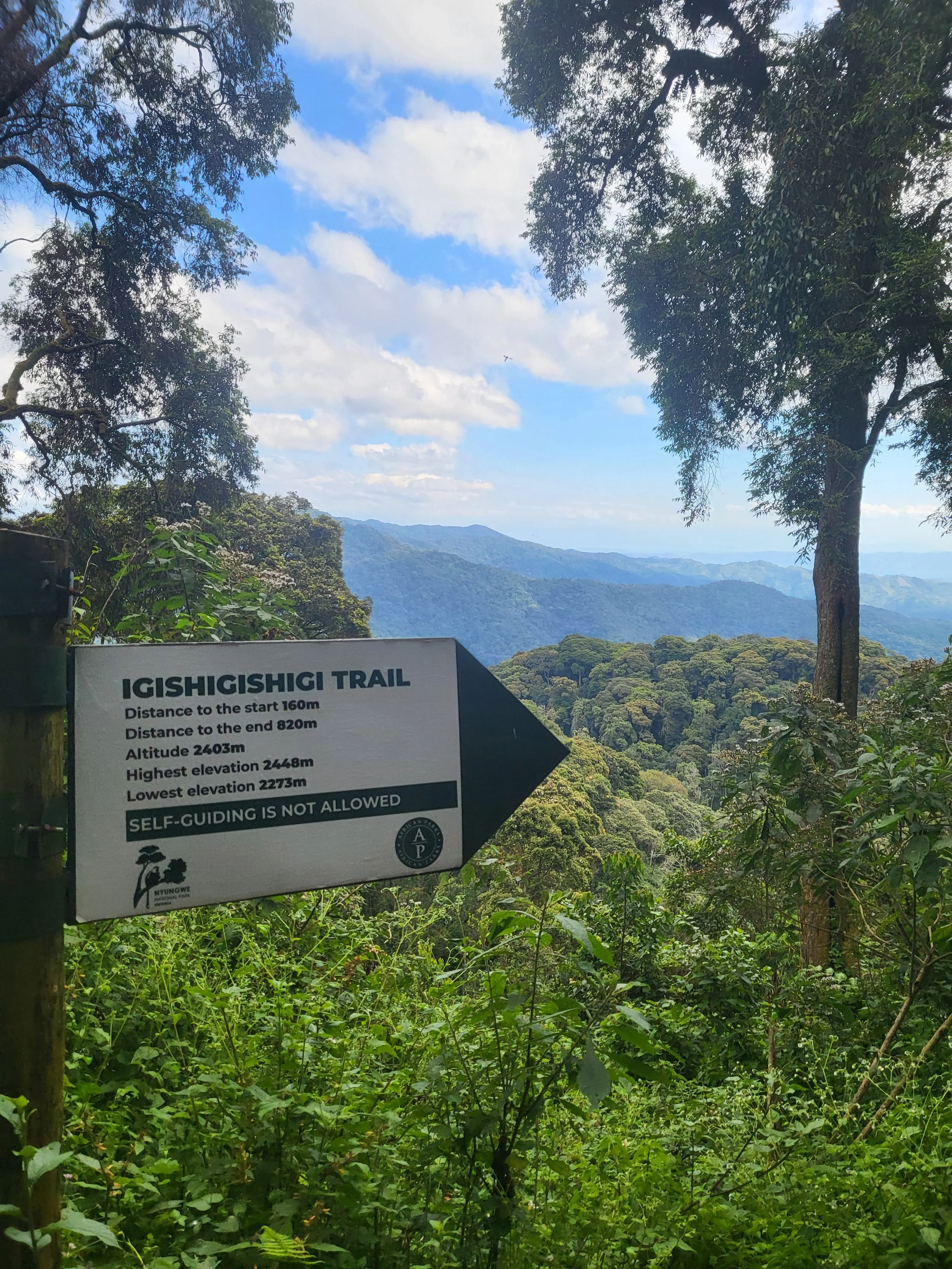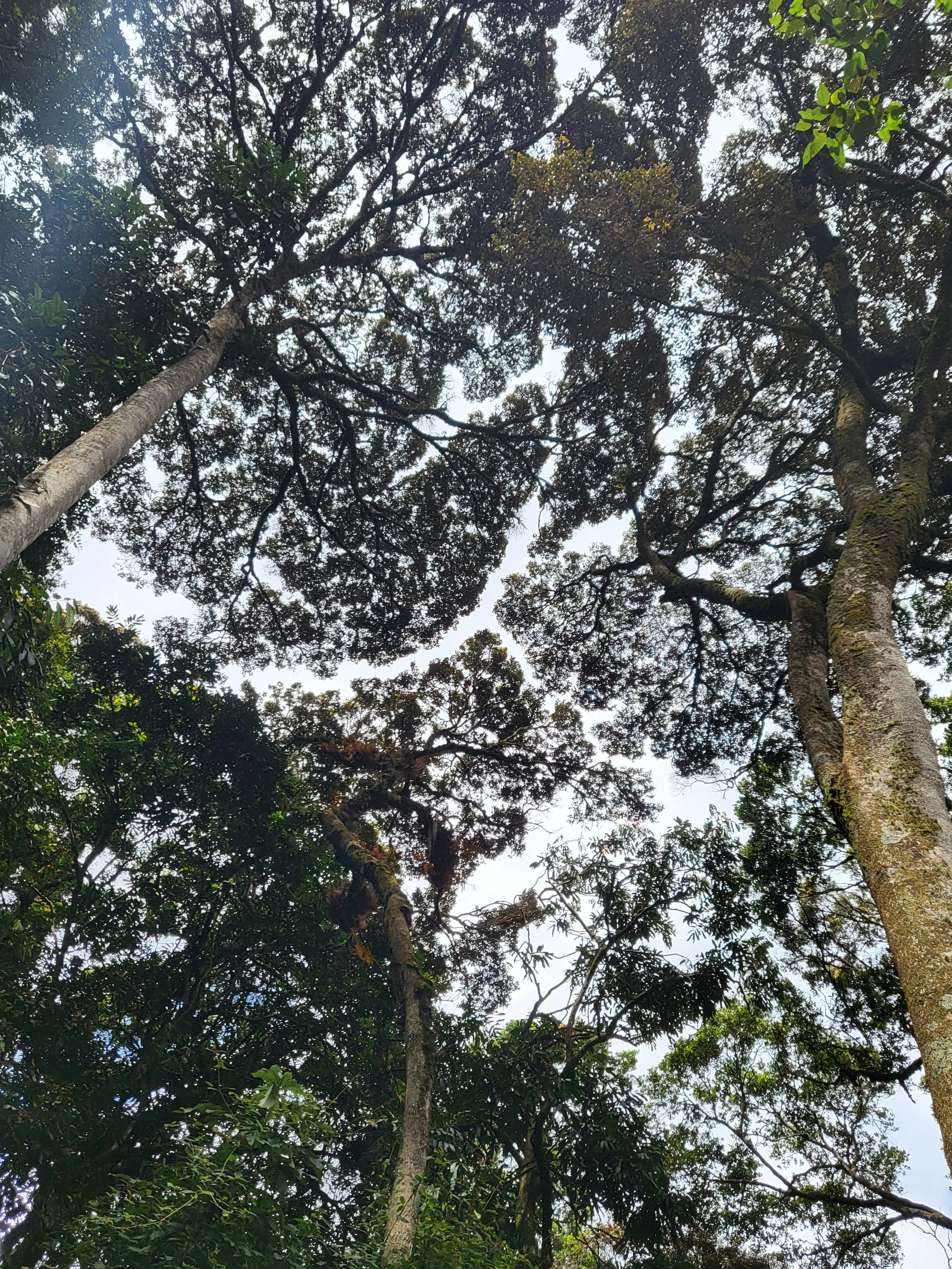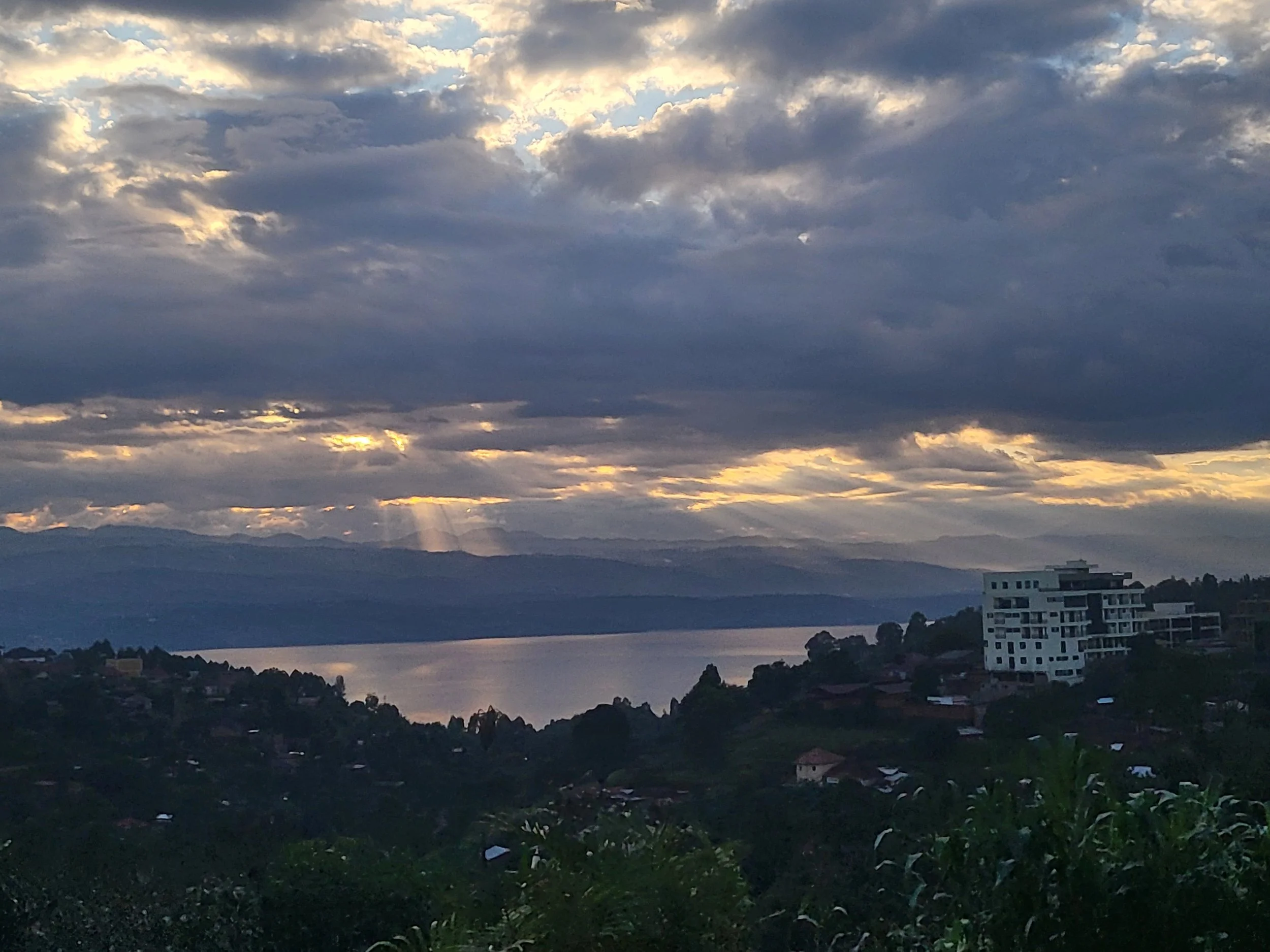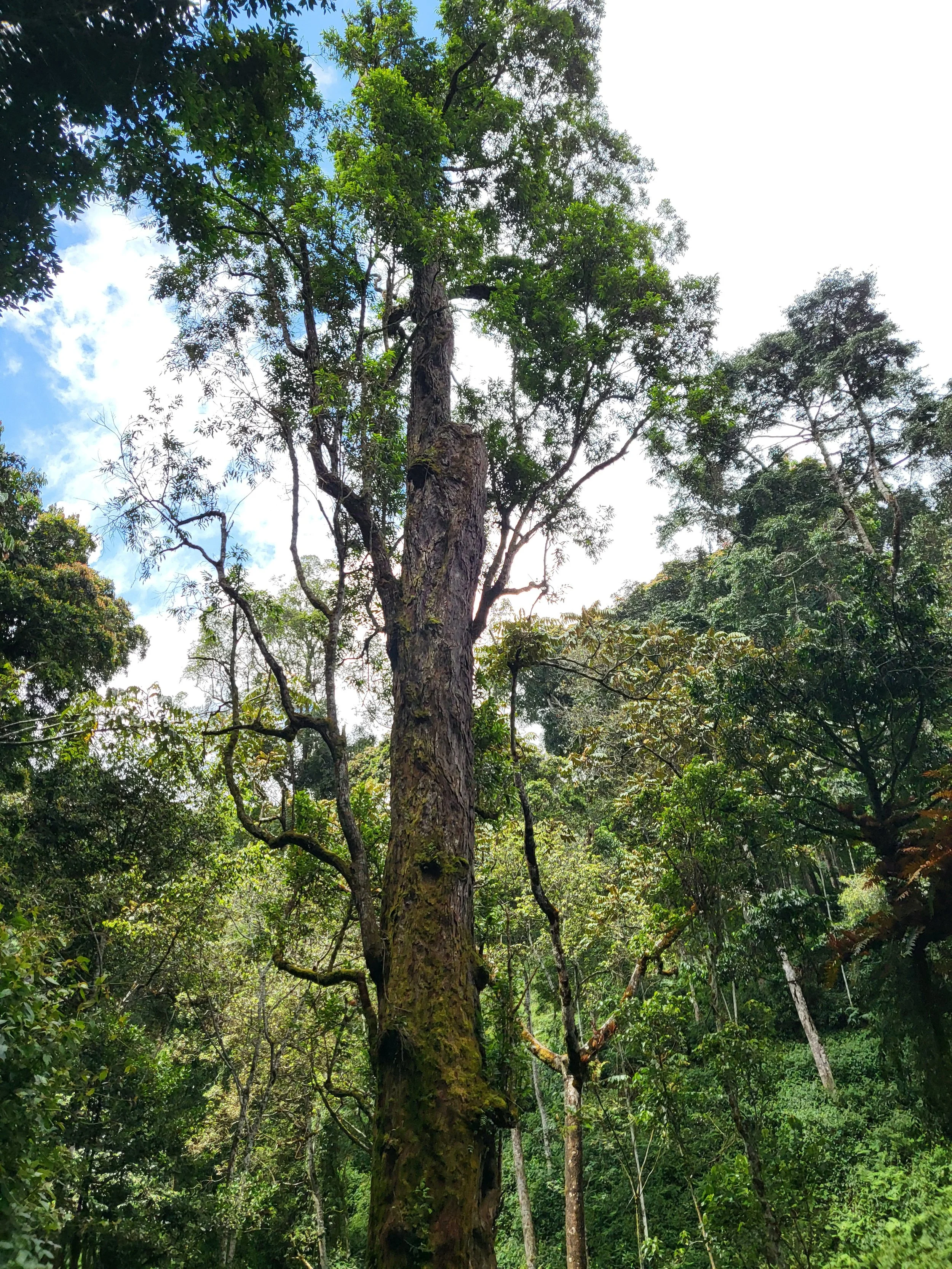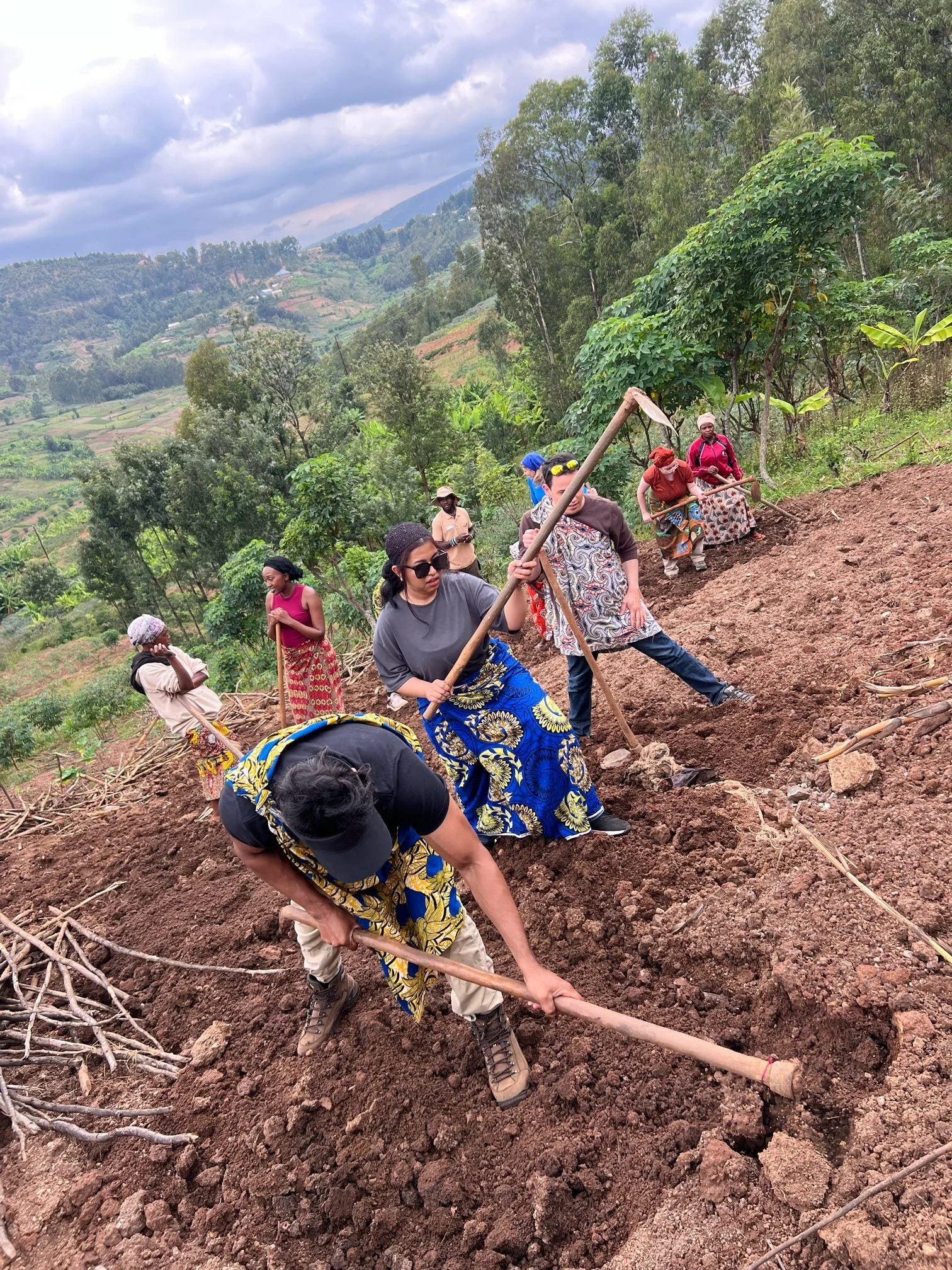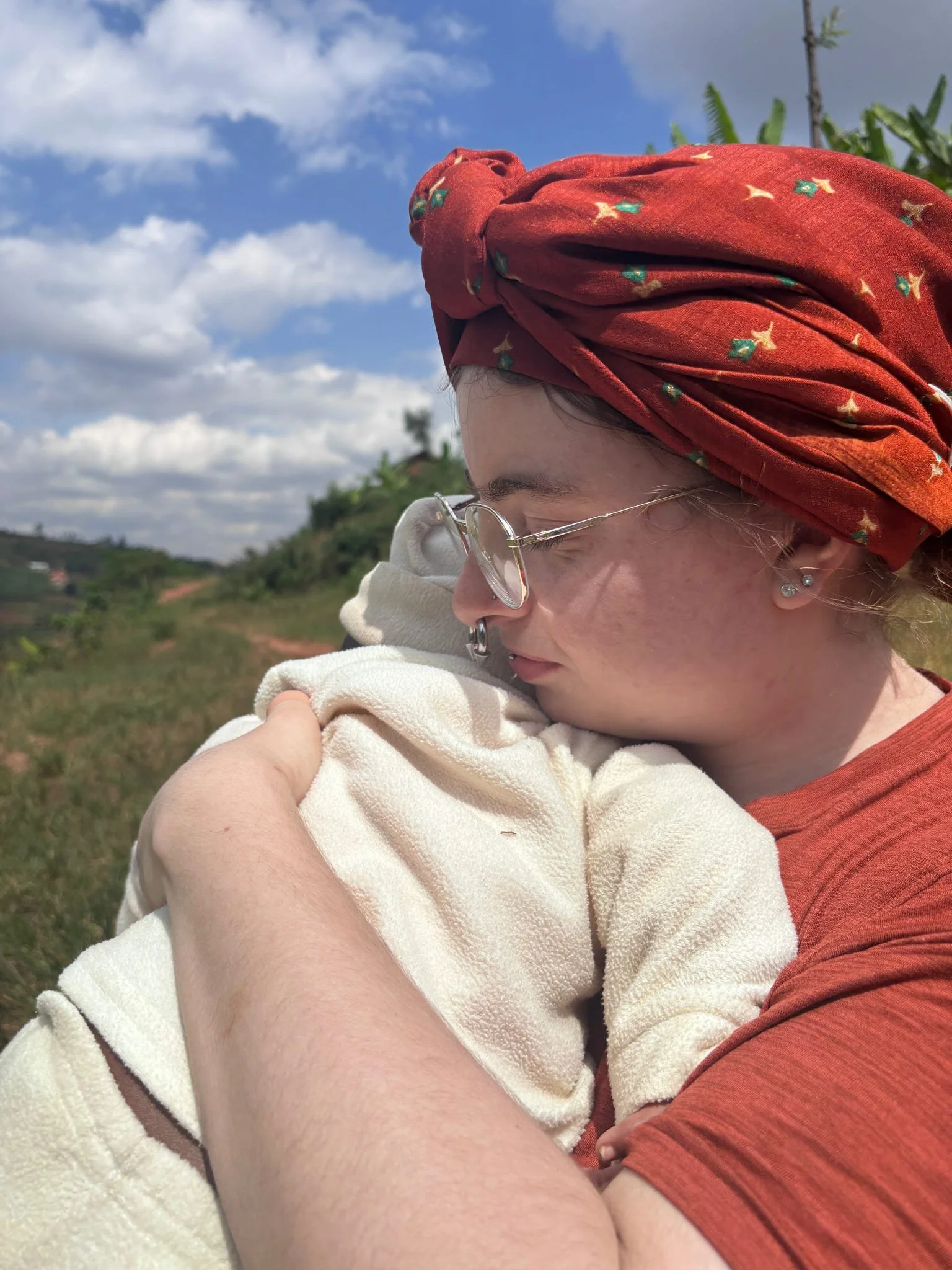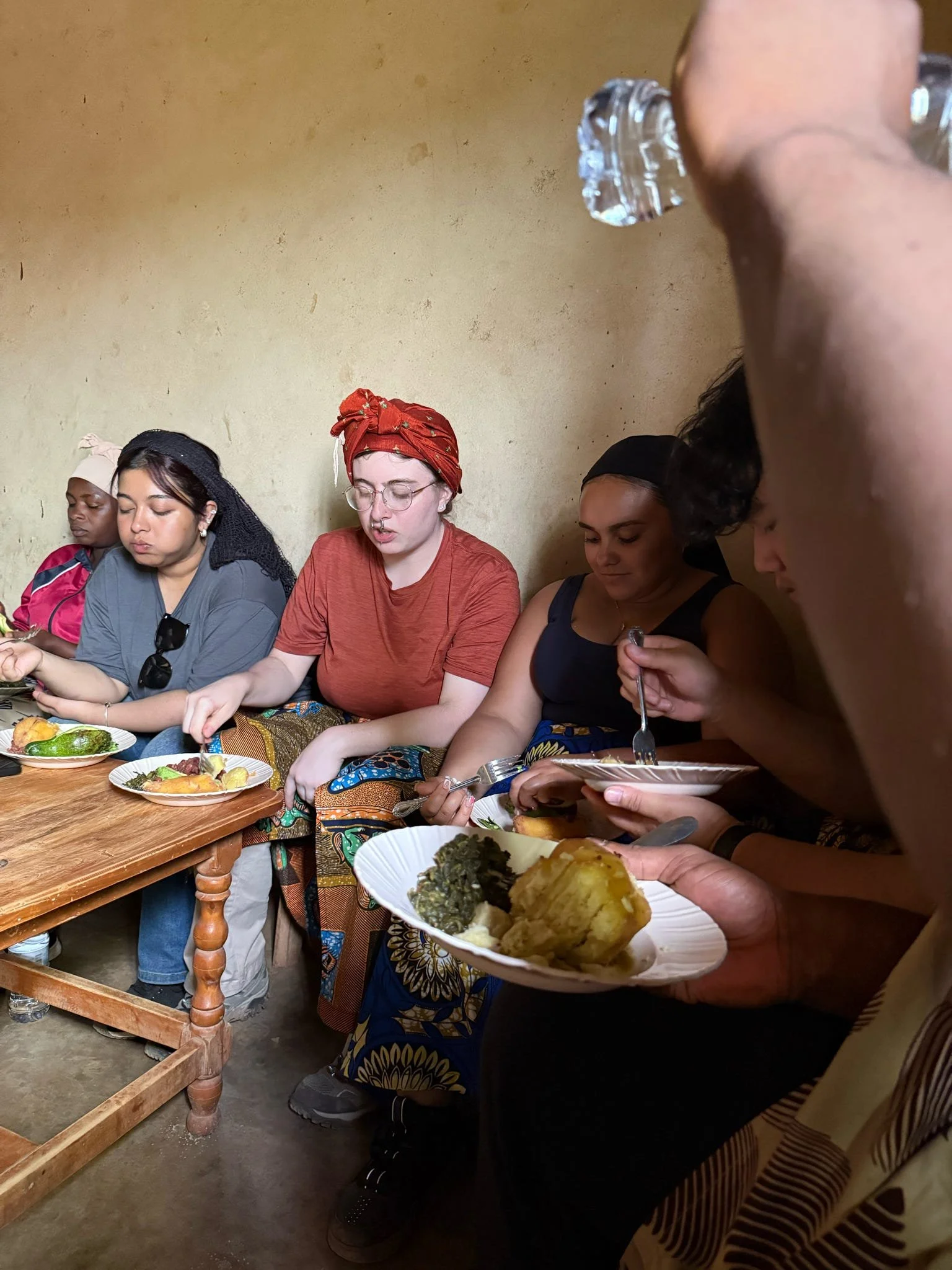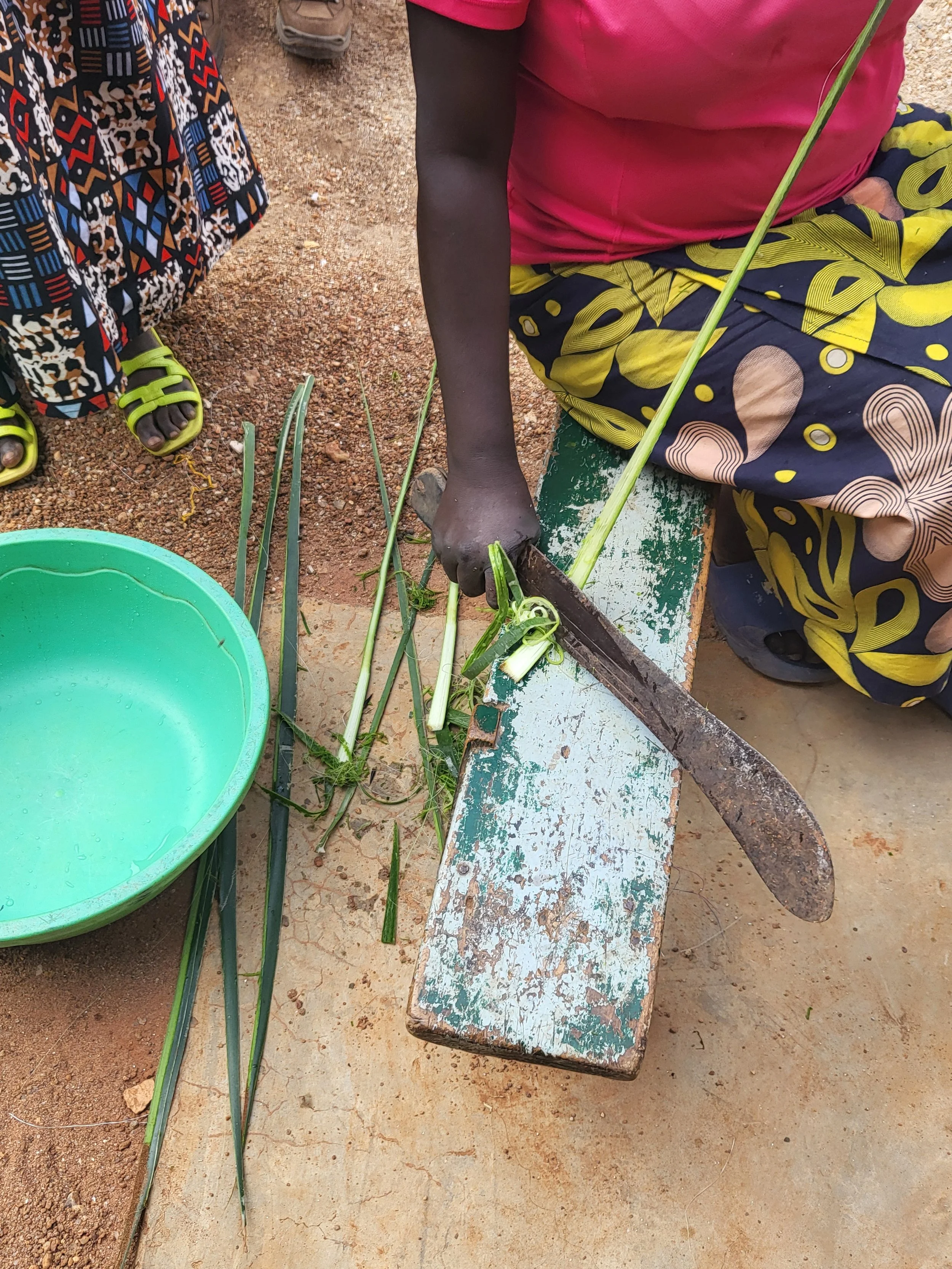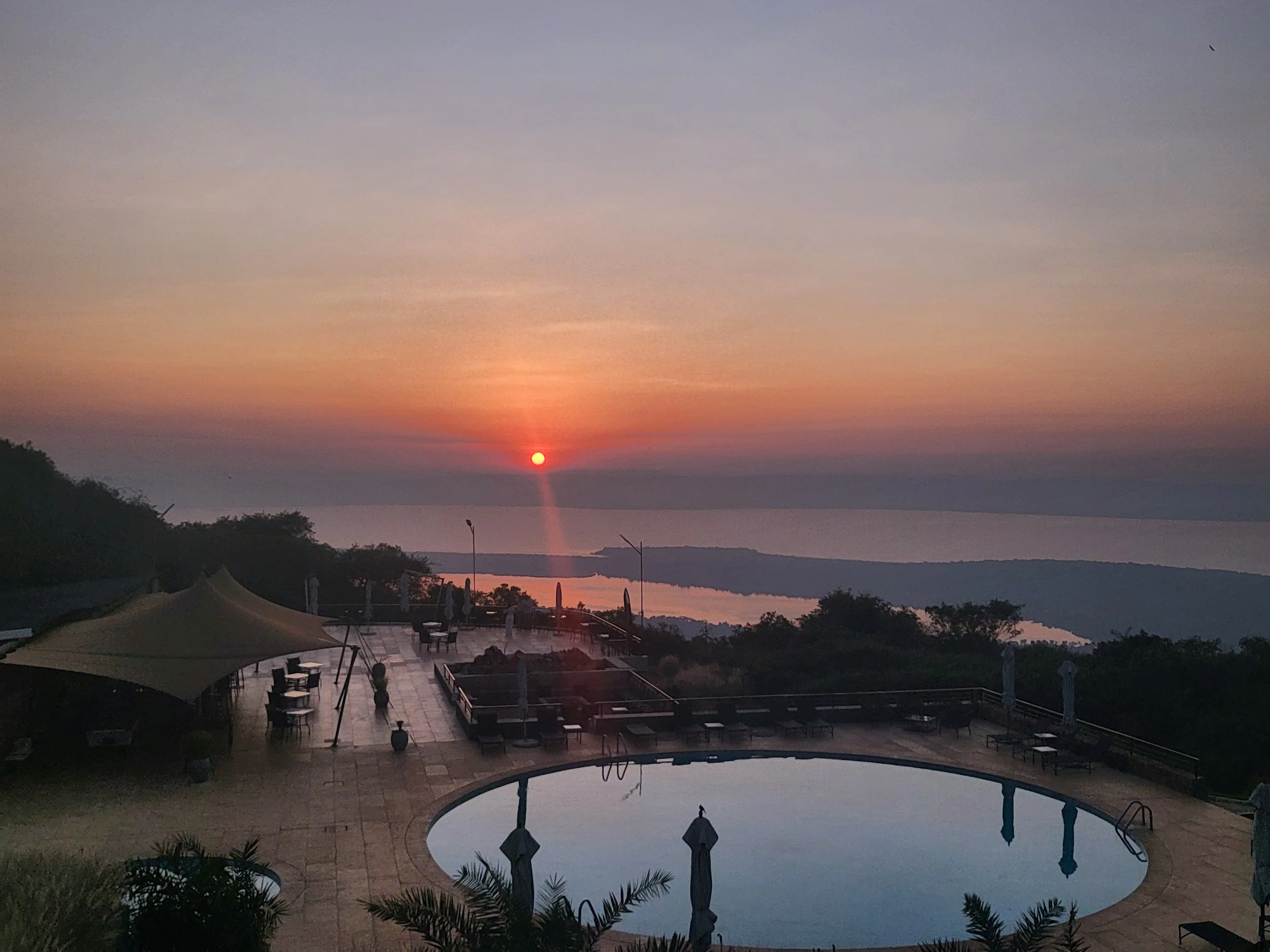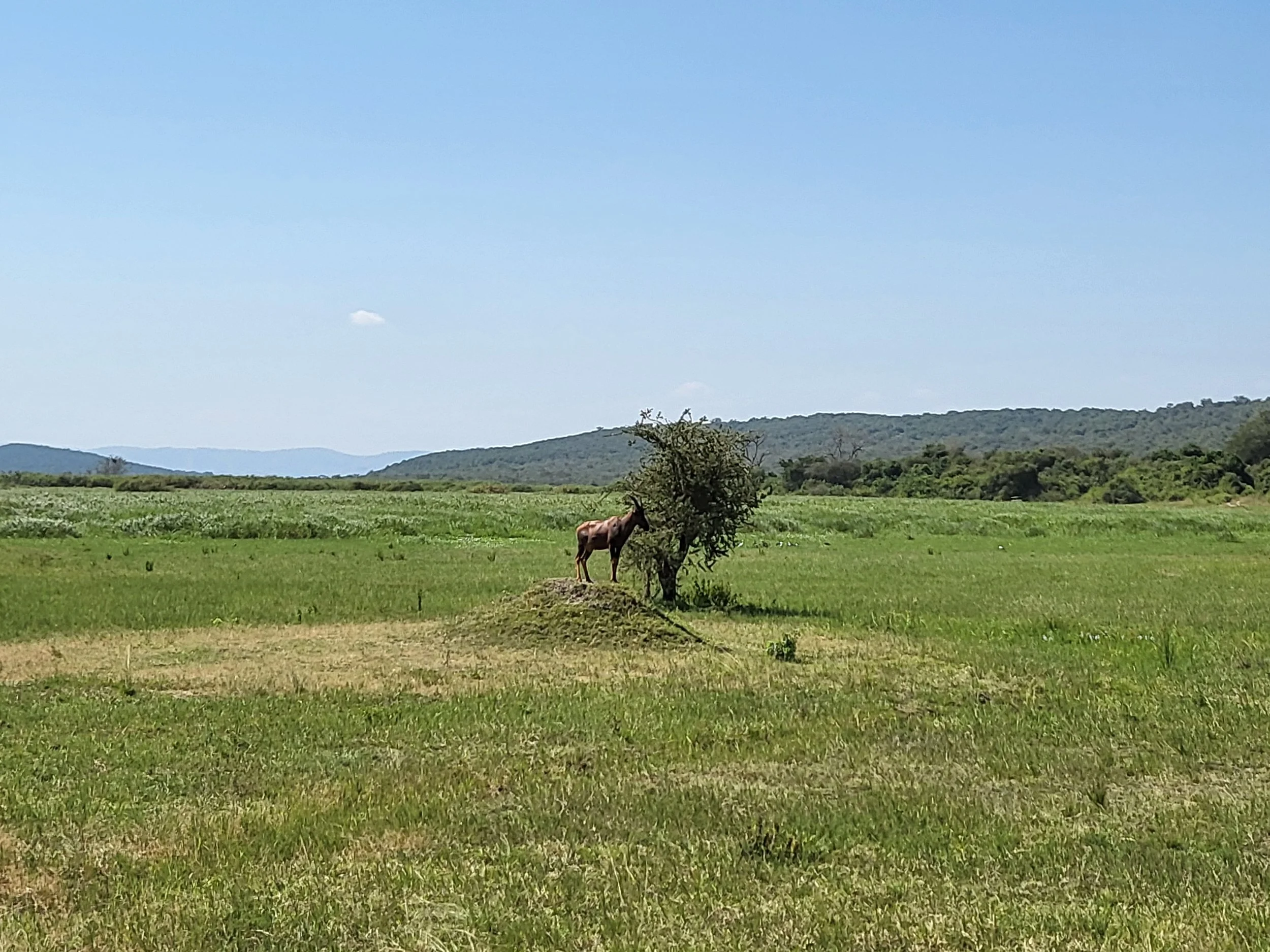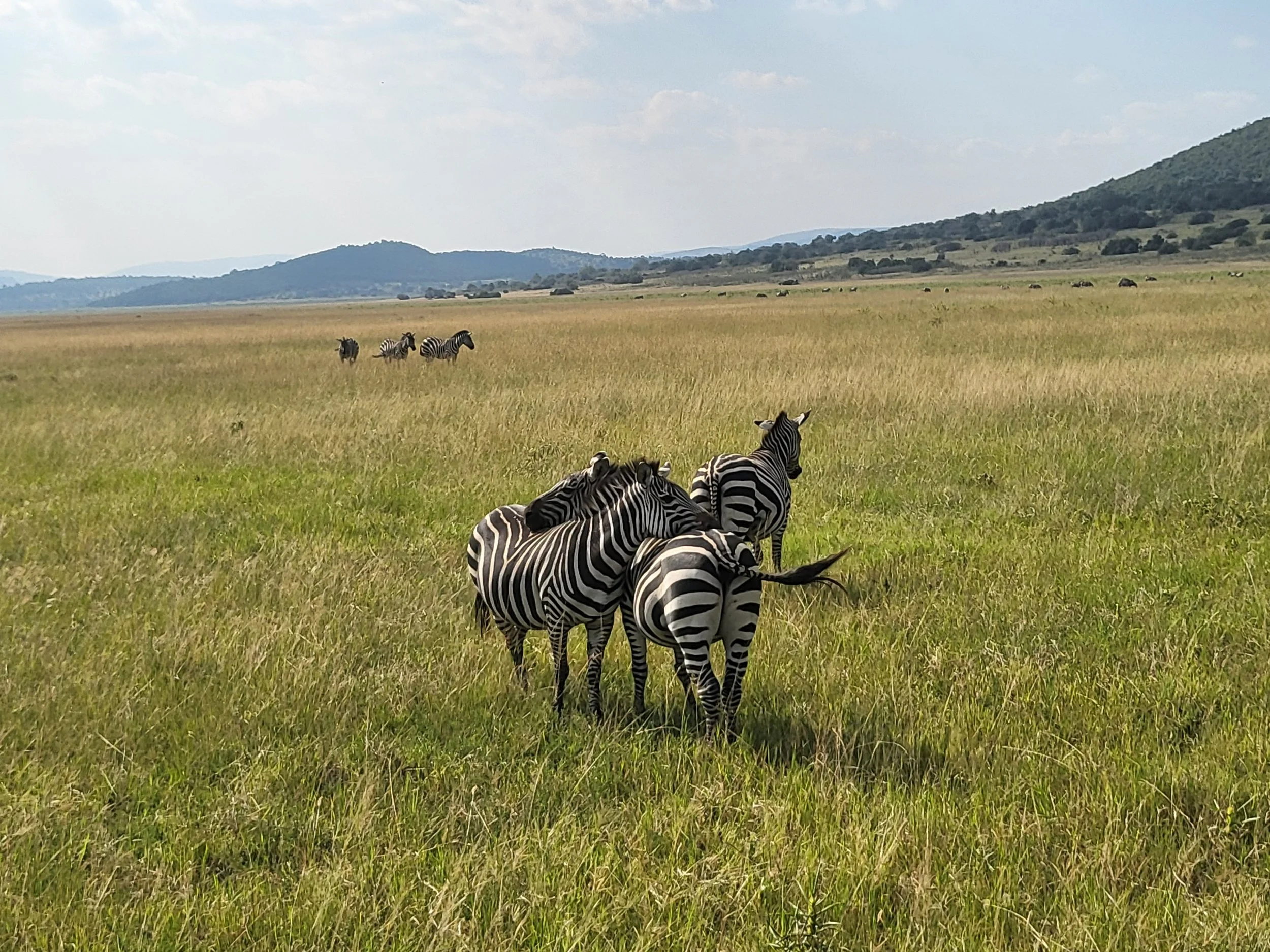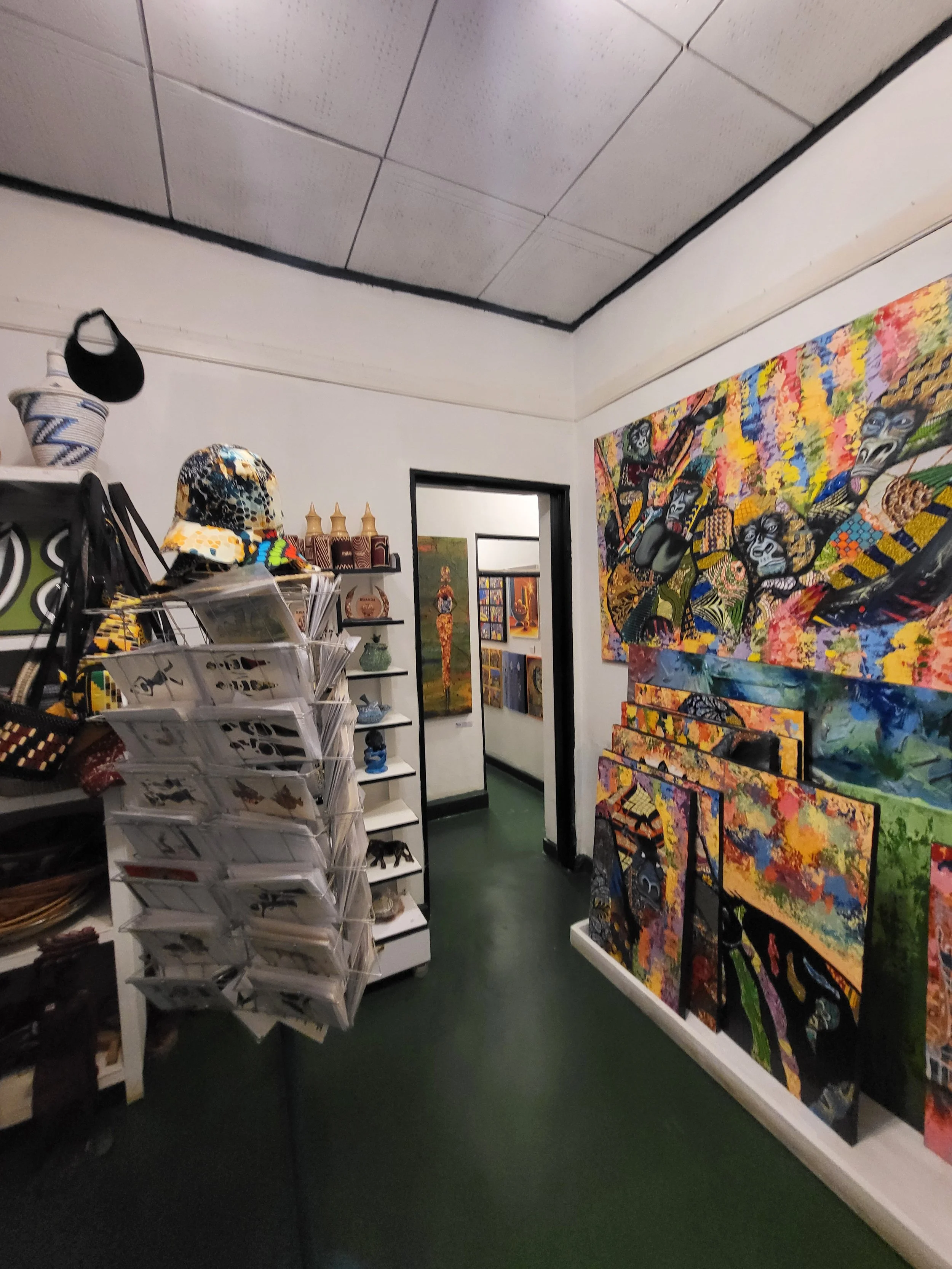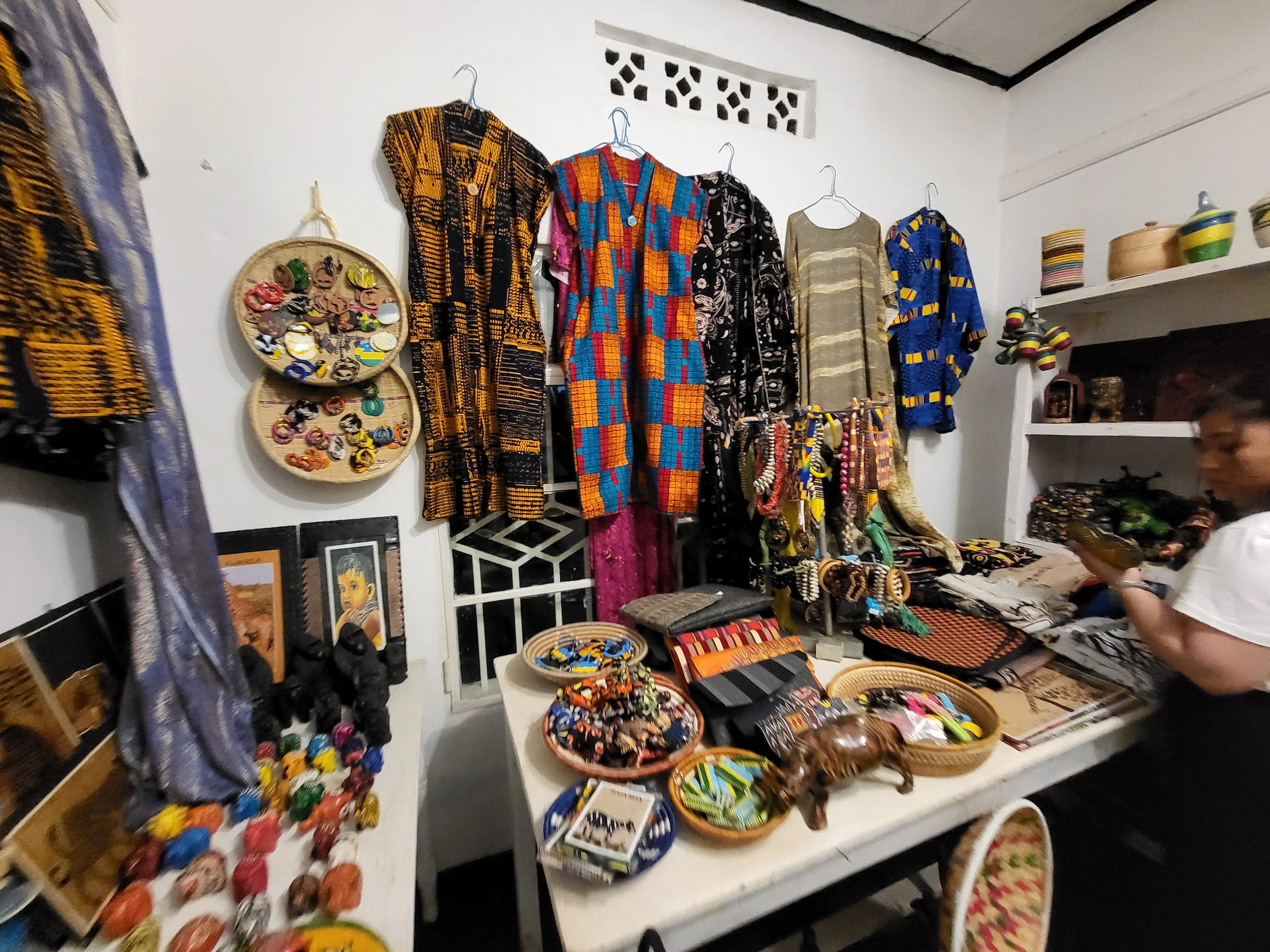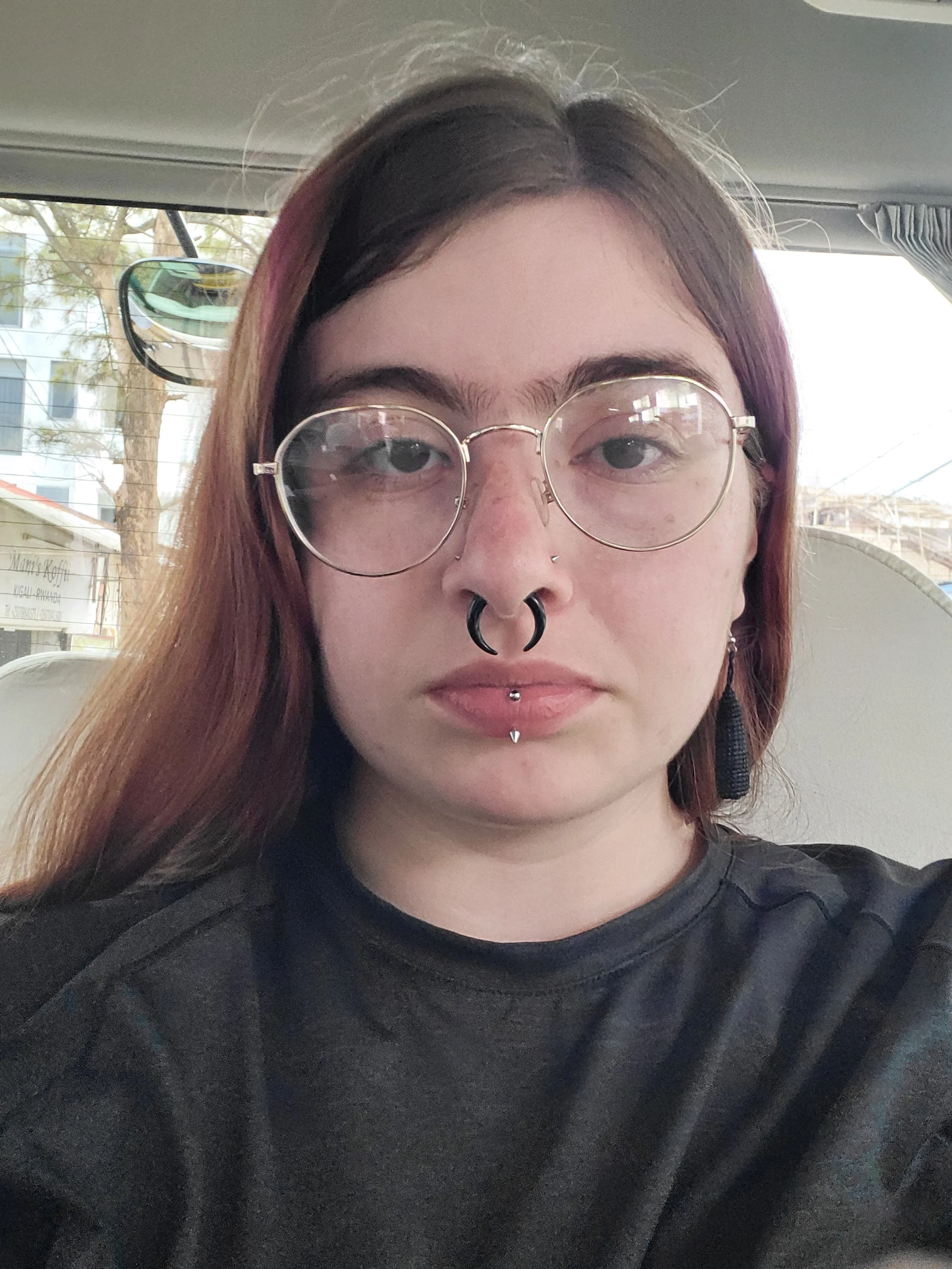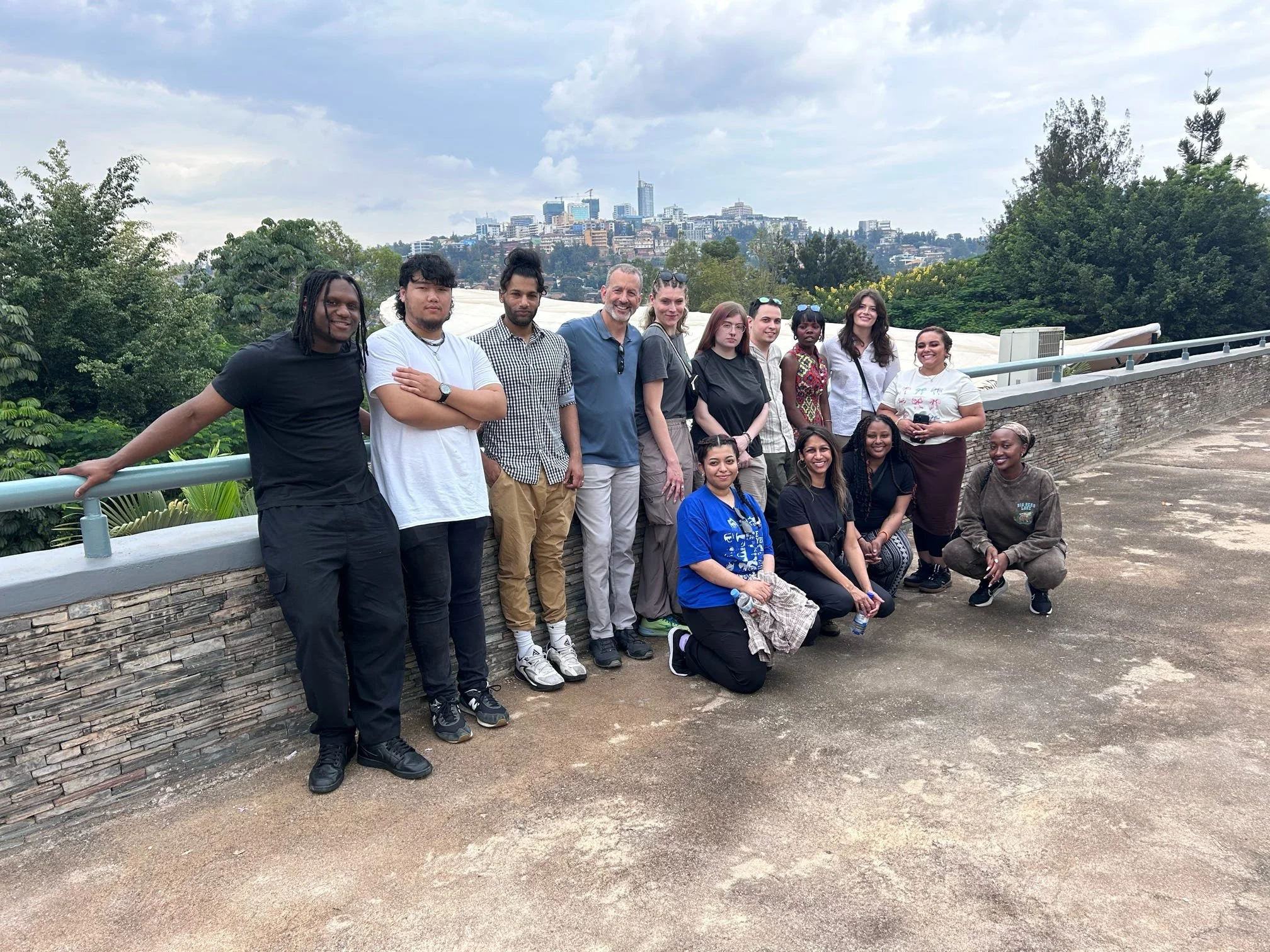2025 Rwanda Delegation— Cadence Aguilar
Social Work ‘26
I think that forgiveness is a skill that can be learned, and there is great benefit in knowing how to acknowledge something that had happened, but to have the ability to move forward in life despite that.
I hope to learn more about the process of forgiveness, no matter how long or messy it may be.
This will be my first time traveling abroad, and I am excited to be able to experience it with a village that I love!
June 4, 2025
"Rwanda has one of the youngest populations in the world."
A seemingly surface level fact given to us on our first day that, while fascinating, is daunting in real-life context. This was one of our first introductions into our stay here and is a result of the 1994 Genocide Against The Tutsi In Rwanda. When families and parents are killed, who is left but their children who have now grown up?
As we went about our first day, settling in, exchanging our money, driving through Kigali, I held this fact in the back of my mind. A vast majority of the Rwandans I saw in Kigali were young adults, seeming to have been born in the 80s and later. I'm interested to see how the population will change as we move throughout the country, and how life is lived outside of Kigali. I am especially excited to meet the teachers this weekend at the Urukundo Center in Muhanga.
One fun fact I learned about life in Rwanda today is the existence of Mototaxis! The taxi service is simply riding on the back of the moto, and the driver wears a taxi vest and helmet. They are everywhere, interwoven into traffic tenfold, and the yellow helmets of the drivers reminded me of little worker bees. You won't go more than a few minutes ride without seeing dozens, if it even takes that long.
June 5, 2025
9:55am
We were told that we were approaching the dry season, and to not expect too much rain. However, we have been greeted yesterday and today with a nice, cool, earthy smelling rain. It is extremely refreshing.
I've done my hair routine much more simply than usual. I double shampoo and then use leave in conditioner. My hair is unbelievably softer than it has ever been in America, and it is without a doubt thanks to the water.
11:00am
We arrived at the Nyamirambo Women's Center and received a tour of the neighborhood. The center teaches primarily women how to sew, do hair, and other ways to make a living on their own. Some work for the center sewing and embroidering and are paid by the piece. Those who take seeing class to practice make school uniforms, which can then go to children, as even if they mess up the piece, children will grow out of it. While some of the items they sell may be more expensive, all the money earned goes back into the co-op and paying the women. From there, I got a hat and some earrings. We then ate lunch as provided generously by one of the original founders of the center after our tour. I already know I will miss the food when I return home.
On our tour, we visited a milk bar. This was a culture shock to me, as someone who absolutely loves dairy. The milk was extremely creamy, and we had ice cream later that day that was unrivaled by any other ice cream. Ice cream in America will never taste the same. Here, we learned that "You have eyes like a cow" is a compliment, given the love of cows in Rwanda. Cows are loved, but are not sacred, and beef dishes are common.
2:00pm
As we arrived at the memorial, I saw a group of children here on a school trip. One smaller child, no older than 6, looked around nervously, and then ran up to me and said, "Hi!" And waved at me excitedly. Professor Kahn told us later that visiting the Kigali Genocide Memorial is a regular trip for school children. Paraphrasing, he said that teaching children at a young age about what's happened and arming them with the truth and empathy helps to prevent harmful ideology from permeating their mind as it relates to hate.
While going through the memorial, there was a specific order that the memorial was to be walked through in order to gain the fullest understanding of what happened. I was decently emotional throughout the entire memorial, so I did my best to ration my tears, but I then made it to the room full of pictures of victims of the Genocide. There were over 1000, and I wanted to take my time to look at each one. My eyes then stopped on a framed wedding photo. The couple looked so beautiful, almost as if all their happiness was captured in that moment. For whatever reason, that was the photo that broke me down. I sat next to another woman who was also silently crying and wiping her tears. This mourning is to be expected, so we both sat there crying in silence, gently wiping our tears. Even thinking back to it still pulls on my heart.
The children's room was a dedicated area of the memorial that displayed child victims of the Genocide. In genocide, nobody is safe, especially women and children. Many of the photos of the victims did not match their age at death, as some of the photos were the last or only photo taken. You could read their likes, dislikes, and finally, their cause of death. Stabbed in eyes, slammed into a wall, shot in the head. These were just a few gruesome ways the children met their end. It is very easy to imagine these children having been your own children, siblings, or cousins.
At the end of our time there, we placed flowers on some of the mass Graves here. There was one grave not yet sealed, with space for more inside. Bodies are still continuously being exhumed and recovered, and will eventually end up laid to rest here, too.
One fact I learned today in both the memorial and on the tour is that during the genocide, people were killed in Christian churches, but often not killed in mosques, out of a fear of spirits and divine retribution. This lead many people to convert to Islam from Christianity.
June 6, 2025
MORNING IN NYAMATA:
We walked into the Nyamata memorial, which was previously a church that held thousands of Tutsis during the 1994 genocide. The church was seen as a safe space, not expected to be desecrated. Knowing this, the very first thing you notice while outside is the sheer number of bullet and grenade fragment holes in the ceiling. Walking in and to our left were multiple bins of bone fragments. One for skulls, one for arm and leg bones, one for smaller pieces. Recently recovered skulls and bones that have not yet been laid to rest. On each pew lied mountains of clothing from the victims. You can see how the aged blood has deeply browned all the clothes. Looking closer at each article, I saw many shirts and hats that I've seen anyone wearing today. It's a dark reminder of how recent the genocide was.
We saw a large number of skulls and bones displayed in the basement, where you can see the extent of the damage under the white light. Bottom halves of faces missing, skulls shattered into pieces from blunt force trauma. The most heartbreaking is seeing the skulls of children and younger people, where you can tell that their growth plates didn't get a chance to fuse yet.
We then exited the church, and we were allowed to walk down the steps into the mass graves. Shelves and shelves of coffins, each having to hold multiple bodies. Up to this point, I was emotional, but I was remaining as stoic as possible. But each of the coffins was littered with notes from their loved ones in Kinyarwanda. I saw Rusi reading one, so I asked what it said, and it was a family member saying how their parents and siblings were taken too soon, and that they hope they are resting in peace.
AFTERNOON IN RECONCILIATION VILLAGE:
We then headed to a reconciliation village where we were greeted by song and dance. We then heard testimony from a survivor and a perpetrator, and the perpetrator was the same person who killed the survivors family members and almost killed her as well. In 1992, different color roofs were given to distinguish the Tutsi, making it easy to target and kill them. In 1994, the Interahamwe came with weapons such as spear, machetes, and other tools. "Use whatever you have" were the instructions given. The survivor explained how she had her children cut into pieces in front of her.
At the beginning of the reconciliation process, there was still a fear of getting killed. Forgiveness and trust were built over a very long time. According to the testimonies, it takes a long time, but it is necessary to have conversations and to keep talking about what happened. Through the sharing of testimonies, survivors and perpetrators have not only forgiven one another but have become close friends.
The reconciliation process is rooted in Restorative Justice that is facilitated by trained volunteers. Restorative Justice has allowed for healing of everyone affected by the genocide. Those in villages are sometimes asked to go outside of the country and share the reconciliation process. Intergenerational healing is also needed to empower younger generation and know and understand legacy of their parents.
Even 30 years later, some people are just now going through healing and realize that they are not alone. Some people lost faith in religion due to the deaths in churches as well as the hate speech and aiding genocide from pastors. After healing, the survivors are able to reattend church. One amazing thing we learned is that reconciliation villages have not failed yet in any single instance.
When speaking about the blame placed on perpetrators, there was also great blame placed on the previous government for orchestrating hate over the course of decades, as well as giving explicit instructions on how to kill the Tutsi. One perpetrator describes how this hate was instilled in him since childhood and was even taught in schools. The Tutsi were reduced to less than human in the perpetrator's eyes, which made killing as easy as it was at the time.
The biggest takeaway the survivor had is that mistakes are not corrected by other mistakes, so you can't kill in retaliation of killing.
JUNE 7-8, 2025
For our three days of Story-Based Learning, we were led by teachers who work at the Urukundo Learning Center. Gianna and I placed in group #3 with Teacher Rémy. We did our warmup exercises with our group of teachers that Professor Kahn taught us during the semester, but it took us as students much longer to become comfortable when we first learned. The teachers, however, caught on instantly! At the end of our first day and for much of our second day, the teachers switched entirely into Kinyarwanda while planning our story presentation.
We had created a story of harvest where we ended up with a poor harvest due to our agricultural practices, so we came together as a village and learned the correct way, and we all then shared the harvest and rejoiced together.
These stories are portrayed through body movements and dramatic sounds, so despite the language barrier, Gianna and I were still able to gather what was being communicated (for the most part!). The story we created was so well done that it transcended language the way it was supposed to and was easy to understand. We also learned many songs and dances used in schools, such as I Have The Ball and Do What I Do.
JUNE 9, 2025
After two days of this training, we arrived back to the Urukundo Learning Center on Monday to see everything in practice. The kid's morning assembly welcomed us with a welcome song and the macarena. If I came to school dancing in the morning, I probably would have enjoyed school much more as a kid!
Kids are preparing for national exam to take place on June 13 and are taking mock exams. Gianna, Rusi, Riva and I looked over the tests, and let me say, the overall English comprehension and writing skill are much better overall than equivalent grade levels in America. Giana and I then oversaw a grade 5 class, where the subject was geography taught in English.
When Professor Kahn said that Rémy was in the top 1% of teachers in the world, he was right! The students absolutely loved and adored Rémy, and he is well-respected.
Kids are not told to be quiet or stay in their seats. They are excited, and their energy is encouraged. The students were nearly leaping out of their seats, saying, "Teacher, me!" Rémy often asks the students to come up to the front of the class and physically demonstrate certain topics, which employs SBL at its finest. Sitting in the class, I learned more about Rwandan geography and what is in each of the five districts.
As you walk around the compound, the children love to shake your hand and say hi, and are very polite. There is also a sewing school, a dental clinic, and animals such as chickens and cows. I have not mentioned this before, but the Kinyarwanda word for White person/foreigner is Muzungu. No matter where we go, I will hear whispers of "Muzungu". There will also be a lot of prolonged eye contact and staring with passersby, as if straight into your soul. I have had a few questions about my piercings, and I have enjoyed explaining and breaking stigmas on my appearance, especially to the curious teachers I have worked with. I did also have a teacher record up close to my face and have me take a selfie with her. Overall, it was a great weekend where I learned more from everyone here than they learned from us.
June 10, 2025
ORIGINS OF COFFEE
We spent the first half of today in Huye, at the Huye Mountain Coffee. As explained by our guide Eric, coffee originated in Ethiopia, and as the story goes, goats were eating the berries that make coffee and started acting "crazy". The goat herder shows his wife, and her and the people decide not to eat the berries, under the assumption that the devil is within them. So they burn the berries to burn the devil out of them. However, this ends up roasting them, and the coffee aroma spreads. It was later realized and used as a medicine to fight against sleep and was chewed on during prayer, especially in Yemen.
Despite Rwanda's closer proximity to Ethiopia, coffee did not reach Rwanda until 1904, brought by the Germans to the Rusizi district.
There are two main types of coffee, Arabica and Robusta. When coffee made its way from Ethiopia to Yemen, is then gained the name Arabica. Indonesia got Robusta coffee, and remains a large producer of Robusta.
COFFEE ECONOMICS
Coffee primarily serves as an export in Rwanda, with 97% of coffee produced in Rwanda being exported, and only 3% kept for domestic consumption. However, 2% of that is consumed by international visitors within the country, making only 1% of the coffee consumed in Rwanda consumed by Rwandans. In Rwanda and Huye Mountain Coffee, it is preferred to sell less, but with high quality, since there is not enough land to grow a large amount of coffee.
Coffee is now one of the four major cash crops in Rwanda alongside tea and pyrethrum. Pyrethrum is used in pesticides and is a flower found in places such as Akagera (we will be going here soon!).
Ethiopia has good quality arabica coffee, as Ethiopia has a large coffee culture and coffee ceremonies, as well as a 50/50 split of domestic consumption and export. Rwanda has banana beer and milk as main drinks instead, but there are coffee shops that have popped up more recently to encourage the consumption of coffee here.
COFFEE GROWTH
For coffee to successfully grow, it must be grown at an elevation of 1500m to 2500m, no more and no less. Coffee needs CO2 to grow, which is often greater at higher elevation. The climate must be moderate, not too hot or too cold, or the tree will not properly grow. There must be enough rain during the 8 months of growing season, and there cannot be any snow, which is why coffee is not grown in countries that experience the winter season. The first production of coffee beans from a tree happens after 3 years. After 10 years, the trees are old, production quality deteriorates, so the trees must be cut and replanted. After that, production takes 2 years instead of 3.
There are trenches dug in increments every certain number of meters to catch water during heavy rainfall to not destroy the topsoil and to evenly distribute water to the roots of all the plants. Other trees are planted alongside coffee trees as to protect from the sun and to help protect the soil.
Arabica is a soft tree and needs a lot of care, pruning, weeding, and mulching. It has many flavors and is known for its aroma. Due to this more intensive care needed, it is more expensive. Eric recommends 100% arabica, not to be bought blended. On the package, it is important to check the elevation and fertilizer used to make sure it is grown organically and in the proper conditions. Just to name a few of the arabica flavors, there is orange, chocolate, and caramel.
Robusta, on the other hand, is a strong tree, as it can be planted and left alone without much extra care needed. However, it is bitter and usually used for blends. You get more quantity, but less quality, and Robusta has lots of caffeine. It is common in Latin America, with Brazil being #1 for Robusta production. Other places that grow Robusta include Colombia, Costa Rica, Guatemala, and Hawai'i.
To fertilize the coffee, the skin of rice and skin of coffee is used. Practices like this make Huye Mountain Coffee certified organic coffee. Eric also taught us of the "Enemies of Coffee", not the coffee haters or tea drinkers, but diseases that can befall coffee trees. There are leaf diseases caused by fungus, which causes the leaves to change color from green to brown, brown to yellow, and yellow to black. Coffee Berry Borer disease is caused by ants, and at the connection between seed and tree, minerals are taken through the ant bites. The seeds then dry up. Where 6-7 kilos are expected for a tree, this disease can cause only 3 kilos or less from a tree.
COFFEE HARVEST AND ROASTING
Red berries are mature enough to be picked, and 8kg of red berries gives 1kg of green coffee to be exported. Berries are sorted and discarded in each part of the process. The quality control practices are how 10kg of cherries gives only 1kg of roasted coffee.
We got to the top portion of our climb up the plantation, and most people took turns roasting coffee. You could tell by smell alone when the coffee was done roasting. You could also see Mount Huye across the way!
Fermentation for standard beans takes 8-12 hours. The beans are then sorted for impurities. Afterwards, the beans are put outside to dry, which takes 2-3 weeks.
Orange berries are used for the honey process, where you don't wash the beans and only take off the skin. This gives the coffee a sweeter and fruiter flavor.
Anaerobic is fermented for 72 hours, and the skin stays on to keep the oxygen from permeating. This is to give the coffee a lower acidity and a smoother feeling. The grade of coffee is determined by its weight.
P.s. don't worry friends and family, I am bringing you back some coffee!
June 11, 2025
This day was spent in Nyungwe National Park, and we took the Igishigishigi Trail, considered to be the easiest of all the trails (by Rwandan standards, it was still a very difficult incline for me). The ferns here are very large, as they used to be eaten by dinosaurs. It's very hard to fathom the size, and even the attached pictures don't exactly capture their size.
70% of the plants here can be used for medicinal purposes, according to our guide. While walking, we also heard the distinct sounds of cicadas, though their call sounds very different. I LOVE CICADAS!!!
For the rest of this blog, I think that pictures can do more justice for Nyungwe than I can explain. Even on the drive, the sky and the scenery is endlessly green and beautiful. I also took short videos (coming soon), but I didn't say much else different from what I've written here already. So anyways, here you go!
June 12, 2025
MAYOR'S OFFICE
To start our day, we met with one of two of the Vice Mayors of Muhanga. One oversees social affairs, which includes education, and the other oversees economic affairs. Muhanga is the official sister city of Buffalo, New York, and is where the Urukundo Learning Center is located, where we participated in the SBL teacher training, and where we spent the most time outside of Kigali.
I asked the Vice Mayor what the biggest challenge in education is, to which he explained that it is the sheer number of students in the public education system, and how there is a need for more teachers.
Urukundo Learning Center, for example, is a private school, and is allowed to declare a classroom student maximum, such as a limit of 25 students per classroom. However, Rwanda has a high value on education and wants everyone who is school age (6+) to attend school, so public classrooms can have upwards of 60 students, and the schools must accept them.
We thanked the Vice Mayor for his time and exchanged gifts, and he was kind enough to be able to take a picture with me.
EARLY CHILDHOOD DEVELOPMENT CENTER
We then went to a village with many children under the age of 6, meaning that they are not old enough to attend school, but still need to be cared for. One of the buildings in the village is used as a preschool, and is smaller than the average Buffalo State classroom, filled with dozens of small children.
Alex and I were assigned to go into the classroom, but quite honestly, a few of the children cried and backed away when they saw me. A tall stranger, and sometimes the first white person they have seen. It was a very small number of the children who were distressed, but enough for me to leave all the classroom care to Alex. I instead pivoted to teaching the primary caregivers how to make use of blocks and other toys that we brought for them. The building blocks (similar to Legos) can be used to teach colors, numbers, shapes, and other ways of incorporating visual learning. As I was showing the teachers and demonstrating this, children began to trickle outside one by one, all of them curious, and they quickly learned how to use the Lego blocks to build. Even crying children became too preoccupied with the blocks to cry anymore!
One of the older girls, likely between the age of 5-7, saw me taking the blocks apart during clean up time, and modeled after me and started helping me to take them apart as well.
The official language of instruction in schools is currently English (taking a pivot from French in the 90s), and because the children have not yet received formal education, they do not yet know any English like with the children we met at the Urukundo Learning Center. Playing and having fun doesn't need language, though, so it was easy for the children and I to understand one another and for me to model play for them. Many of the children eventually warmed up to me, but they all were climbing all over Haran. They seriously could not get enough of him.
The caregivers were also very eager to learn from me and we're extremely grateful, despite feeling like I could have given a better lesson. As we left, they danced for us the same way they welcomed us, and I waved out of the window of our bus until I couldn't see them anymore. A few of the women mentioned that they didn't feel as though they deserved our kindness, but I hope that today changed their minds.
June 13, 2025
AZIZI LIFE
We spent a day in the life of women within one of the Azizi Life collectives. Overall, Azizi Life has over 760 people and 54 different cooperatives. Azizi Life means excellent life, and those who work for the collective create crafts to sell in the Azizi Life store, which goes back into supporting the collectives. Despite being a stingy person, I did buy a few things to support.
We spent the day with the Abunurava collective. Abunurava stands for courageous people, a name which was perfectly fitting. We met the 12 wonderful ladies who were going to guide us through our day, all of whom were mothers with multiple children, many similar in age to my own parents. We were greeted with big hugs, dressed in our fabric for the day, and put to work.
We started by meal prepping sweet potatoes, first peeling, then washing, and finally boiling.
We then started clearing and hoeing the dirt, as well as collecting grass for the cows to eat. We learned how to use a banana leaf to create a hold for our head to carry back all the grass.
Once we returned from collecting grass, we departed on a walk to gather water. The water comes from the mountain and trickles slowly, so as we waited for all the other waters to fill up, we played with baby Pamela. Pamela is the most chill and nonchalant baby I have ever met. She is so beautiful and looks exactly like her mother! She especially loved Alex (every baby loves Alex).
We then returned and ate lunch, consisting of sweet potatoes, beans, and dodo, topped off with a banana for dessert. It is very filling food and is great for nourishing hard work.
We spent our time after lunch learning how to create woven bracelets. It took me a little while to get a hang of it, but thanks to the women around me, I was able to catch on quicker than I thought I could!
To create the fibers for the bracelets, the sisal leaves are stripped down until they are dry as shown here, and they are then dyed to desired colors. The fibers are also used for baskets, ropes, and other woven objects that are used in everyday life, as well as for crafts sold in stores.
If I have been reminded of anything today, there is no greater superpower than being a mother. All the women were nothing short of helpful, kind, and humble, and stayed patient with us while we learned how to live different parts of their life. Their motherly love reminds me that I am also still a child, and I have a lot of life left to live.
June 14-15, 2025
AKAGERA NATIONAL PARK
This morning, I woke up earlier than we needed to be up to watch the sunrise. The view from where we stayed was incredible, and I saw nearly a full night sky of stars the night before. We had an early start to our day if we wanted to see the animals before they went into hiding during the heat.
Akagera National Park lies in the eastern side of Rwanda and extends across two of five of Rwanda's districts. Akagera National Park also borders Tanzania, and the two countries are divided by River Akagera. Akagera National Park is a savanna, home to rhinos, zebras, lions, leopards, orangutans, giraffes, elephants, and many more animals.
Akagera, as a park, has been downsized from its original size to accommodate those coming back into Rwanda from exile to give them a place to stay. Initially, there was much conflict between the community and animals, as the lions would kill the cows of the locals. This caused the people, in retaliation, to kill every single rhino and lion in Rwanda.
In an effort to increase these animal populations, animals have been brought to Akagera from South Africa, most notably black and white rhinos. There are now dozens of each, with their populations increasing each year!
The Safari we went on took the entire day, and we started from the south of the park and made our way to the north side of the park. I can't remember the last time I went to a zoo, and I've never seen any of these animals in the wild before. The ride was also extremely dusty, which our guides call a "natural blush".
We were able to see four out of the big five animals, which includes lion, elephant, water buffalo, rhino, and leopard. No leopard this year, but maybe next year's group will have better luck!
These days, to me, are truly a once in a lifetime experience. Between us, hippos may not be a part of the big five, but I was the most excited to see them, and I had never seen them before today.
Usually, they spend the hot day inside of the water and surface to get air, but we were able to find many sunbathing, which I didn't expect. It was a pleasant surprise!
June 16-17, 2025
AEGIS TRUST
We returned to the Kigali Genocide Memorial for two days of Peace Value Education and story building workshops given by Aegis Trust. With everything we have learned and experienced so far, it was time to put it into a greater perspective and relate it to how genocide is taught to others. We started with piecing together the steps of genocide, which sparked great and insightful conversations amongst ourselves, as well as many parallels within the first few steps that we can see in the United States.
1.POOR LIVING CONDITIONS
The first step to genocide is ensuring that there are people who have poor living conditions. Poor living conditions can be more than physical and can leave citizens of a particular place feeling vulnerable. An unstable economy, decline in the job market, and other factors can apply.
2.REFUGE IN A GROUP
When struggling, it is human nature to turn to others who may share our similar experience or hold similar values. In Rwanda, this would have been extremist Hutus and the PARMEHUTU party. In Nazi Germany, this would have been the Nazis and the Hitler Youth programs. In America, this can be seen with hate groups such as the KKK and MAGA Trump supporters.
3.SCAPEGOAT
Many of the poor living conditions may be the result of poor leadership and policy. We see this with many of the changes made by the Trump administration, with recession imminent and tariffs high. However, rather than blaming the government, billionaires, and those with power who are responsible, attention is directed to other groups, and everything becomes "their fault". In Rwanda, this was the Tutsi. In Nazi Germany, this was Jewish people. In Palestine, this is the Palestinians. And in America, this is immigrants, who are "criminals" who "steal jobs".
4.MARGINALIZATION
This scapegoated group is then further marginalized and ostracized. This is commonly done by creating ways to identify more easily said groups, as well as promoting hateful propaganda. Rwandans were required to keep their ethnicity on their ID cards and state their ethnicity when asked and were characterized as having more "Eurocentric" features. Jewish people were required to wear the Star of David on their arm bands and live in ghettos and were further ostracized for ethnic features. In America, people of color are assumed to be immigrants, and immigrants are then assumed to be criminals that should be deported.
5.DESTRUCTIVE IDEOLOGY
Ideology is then propagated by the aforementioned groups, especially in the form of hate speech and hate crimes. Even US citizens, as long as they fit the "description" of an immigrant, can fall victim to ICE and unfair legal procedures. This treatment becomes normalized and accepted by others. Ideas are promoted that the marginalized groups are "less than human" and should not be allowed to work, own businesses, or generally exist in any capacity. Destructive ideology propagated by Donald Trump also resulted in the January 6th attack on the Capitol, where everyone there was later pardoned, making it acceptable to commit such acts in the future under his direction, knowing that there may be no consequences.
6.ABSENSE OF ACTIVE BYSTANDERS
The biggest killers in genocides are not just perpetrators and genocidaires, but those who bear witness to the mistreatment, indiscriminate killing, and hateful behavior, and yet do nothing. The US fortunately shows many active bystanders, as most recently shown with the "No Kings" protests across the country. Much of our citizens remain complicit in wrongdoing and hatred, though. This was certainly the case in Nazi Germany and Rwanda and is especially the case with Palestine. Despite best efforts to protest acts of genocide in Palestine, not enough world governments and citizens care or have taken enough action to end the violence there. The destructive ideology and thoughts of extermination is then allowed to fester further.
7.PAST HISTORY OF VICTIMIZATION
An extreme respect for authority can facilitate the continued hatred of said groups. As previously mentioned, there is a certain subset of republicans that are "MAGA" and remain entirely loyal to Donald Trump, no matter any wrongdoing, hypocrisy, or lies from said leaders. Adolf Hitler was a very powerful and respected leader despite his hateful and problematic behavior. The pre-genocide Rwandan government is the same, and Israelites are made to hate Palestinians under the direction of Netanyahu, who is a powerful leader who enforces hate and division between the two groups.
8.MANIPULATION OF PEOPLE
The vulnerability, instability, and hatred created in citizens then makes it easy to manipulate them into believing that this extreme ideology and hatred is true and correct. Acts of violence and hate speech are encouraged, serving as a precursor to full genocide. It is easy to take advantage of people who have less and whose needs are not being met.
9.DEHUMANIZATION
The marginalized groups are then propagated to be less than human. Former genocide perpetrators in the 1994 Genocide Against The Tutsi describe being able to kill large number of Tutsis easily as they considered them to only be cockroaches that must be "exterminated". This is also taught through media such as newspapers and radio stations, as well as is enforced in educational settings for children. In Rwanda, the genocide was prepared for multiple generation, and perpetrators were taught this ideology from childhood, both in school and from their parents.
10.GENOCIDE
A failing state and the presence of war and other violence can lead acts of violence into full blown genocide. Tensions and hatred are high, and people are strategically and brutally murdered. Some genocides take place over years, where some take place over months. Weapons to kill vary from gas chambers to machetes, and tens of thousands, hundreds of thousands, or millions of people belonging to a specific group are killed.
Facts to keep in mind regarding the 1994 Genocide Against the Tutsi:
-In schools, it was taught that Tutsi people come from Ethiopia and Hutu people come from Chad. In reality, is no ethnic or genetic difference between "Hutu" and "Tutsi", and all people living in Rwanda are Rwandan.
-Acts such as killing Tutsi was not seen as a legitimate criminal offense, whereas stealing eggs was. Tutsis were killed for many years prior to the genocide in preparation.
-While many people may cite the plane crash that killed the Rwandan and Burundian president as being the cause for genocide, this is false. This event merely served as a trigger for the genocide. Genocide is meticulously prepared over a period of time according to the steps above.
NIYO ARTS CAFE
We spent the evening of our first day at the Niyo Arts Cafe, where we learned traditional dance and drumming. I personally preferred to stay on the drums, but I took part in the final dance in the men's line, as I felt I resonated with that version of the dance more.
Niyo Arts Cafe also has a large collection of art in the gallery, all of which is for sale for interested buyers. It felt nice to step out of my comfort zone and dance today, and helped to uplift my spirits amidst the heavy talks of genocide throughout both days.
Now that the trip has come to an end, I would like to acknowledge that I've done my best to give as much information in a factual manner as possible so that those who do not have this experience can learn even a fraction of what I have. I truly wish I could share everything, but I am always open to questions about my experience!
Each day we experienced was vastly different, so I find that different formats have worked better for detailing my experience depending on the day. By reading my own blogs, I find that I am able to relive my experience.
HARDSHIPS
I encountered many hardships throughout my time in Rwanda, mostly relating to my physical health. I got sick twice, had a dramatic allergic reaction where my eye was severely swollen for a day and a half, and had a pretty bad fall where I injured my head. These all happened throughout the trip, and while I was never in any danger or had any threat to my life, I was often very tired or unwell and wasn't always able to give 100%. I greatly appreciate my village for looking out for me and checking in on me every day as I was in a continuous state of recovery, even on the plane home. I do wish everyone could have experienced the best version of myself while on the trip, but I will be seeing many of my peers again, and we are surely bonded for a lifetime.
EVERYDAY LIVING:
Onto some practical parts of living! We stayed in hotels and guest houses the entire trip, so we always had running water, a bed to sleep in, water to drink, food to eat, and much more. Despite this, I really did not want to pay for laundry service in any of the places we stayed, so I washed and dried all my clothes myself. I found myself being stingy even in Rwanda, where USD is only second to the Euro in conversion value. I had a fair amount of money left over by the end, but I was able to use the rest towards gratuity for those in GEI who have guided our trip so wonderfully and taken care of us! At one point, I wished to buy a head cover from the Nyungwe National Park souvenir shop, but it cost 20000 RWF! I loved it, but with all due respect, I was not going to pay that much, so I did not buy it. At times where I could have bartered at the market, I simply did not feel like it and often walked out without buying anything. I have discovered that I am great at saying no.
TRAVEL:
Given that travel takes nearly a day, both days, it was less than ideal in some circumstances. While flying on Ethiopian Airlines, I was a walking culture shock to many people. Even while exiting the plane, I would have strangers stop and stare at me with their jaws unhinged. I knew and accepted that this may be the case before traveling, but it is easy to be caught off guard when someone is staring holes through you. I was extremely nervous to reenter the United States at the Canadian border, but luckily, everything went smoothly. This experience was my first time flying this long, and internationally, and I only got my first passport this year. I have had many firsts on this trip, and I hope I can become well acquainted with other continents and parts of the world, as well!
THE AFP IMPACT:
Whenever we met people, you could tell that their relationship with Professor Kahn has been built over a long period of time. There is often a deep respect and understanding that extends both ways, and the trip has certainly evolved in the 13 years since its inception. The entire trip, Jonise kept our energy high and took care of many of our menial troubles and concerns. We would not have been able to make it through the trip without her.
Finally, I would like to extend gratitude to the many people and organizations who made this trip possible and enjoyable for me. I never thought that I would have a Study Abroad opportunity, and I certainly never thought I'd be able to travel abroad until much later in my life.
Thank you to the Muriel A Howard Honors Program for assisting with financial support me with this trip. I would also like to thank Professor Donn Youngstrom for his very generous support in making this trip possible as well.
I would like to sincerely thank my Grandpa for helping to support me through college the best he can, and for being my ride to and from the airport, even when the time was inconvenient.
Thank you to Classroom Support for being supportive and invested in my trip, and allowing me the time off for this experience, including time to recover. You have greatly supported me financially for this trip, as well!
I would like to thank Min and Haran for always keeping their bromance alive and endlessly offering your hugs to everyone. I always love a hug, and I don't always realize when I need it.
I would like to thank Gianna for playing with me and making me feel as though my extreme love for swimming is at least somewhat normal. If I had an older sister, I'd like to imagine that she would be like you.
Thank you to Riva and Alex for never being judgmental and always allowing me a space in your presence. You both feel safe and reassuring, and I always learn something new when I talk to you.
Thank you to Cameron for opening yourself to the group and showing us your humor. You make laughing feel like it's second nature, and you help me to remember my common sense when I seem to lose it.
Thank you to Bella for being my roommate. That alone deserves major props, but you are also a deeply grounded and humble person. Your mentality and energy is infectious. Never stop smiling!
Thank you to Renata for seeing me. There were moments where only you seemed to have known or seen how I was feeling, and I felt safe and free of judgement around you. You have a gentle way of giving comfort.
Thank you to Rusi for sharing your stories with me. You are a great storyteller, and you have a lot of wisdom to share. You are also very funny, and I've never had a conversation with you without laughter.
Thank you to Ivan and Francoise for putting up with all our curious questions and random needs. The trip would not be possible without you, and you have helped to deepen our understanding of Rwanda. Rwanda, GEI, and the AFP are lucky to have you.
Thank you to Jonise for formatting my very long and arduous blogs, as well as helping us stay upbeat on this trip. You are fun, but get business done when you need to. I respect you greatly.
Thank you to Dr's S for imparting your wisdom on us. You are both so well educated, yet eloquent enough to help us understand everything you teach us. You are both also extremely humble. Not every Professor can do it like you can! And thank you for taking care of my head bump.
Thank you to Rwanda for accepting me with open arms and lots of smiles. Despite being a foreigner, and a sore thumb at that, I never felt unwelcome, and I have never eaten such consistently amazing food at any point in my life. My body and mind thank you.
Thank you to Professor Kahn, all of AFP, and GEI for making this experience possible. Professor Kahn, you have the patience of a saint. Thank you for allowing me on this trip despite my young age and inexperience. I have learned and grown a lot in such a short period of time, and it is thanks to you. I hope to always keep the passion for learning you have helped to give me.



